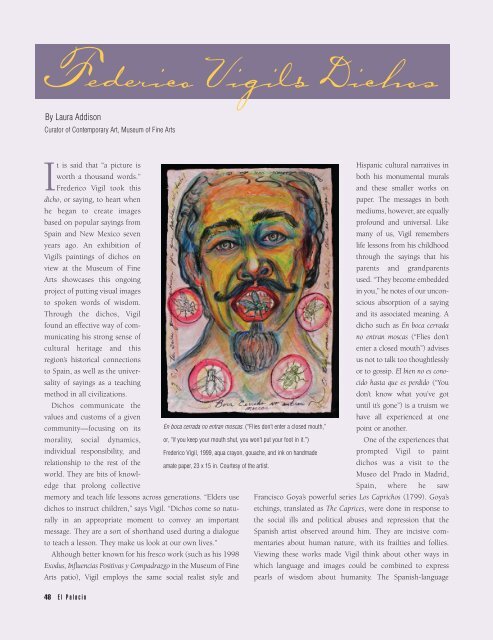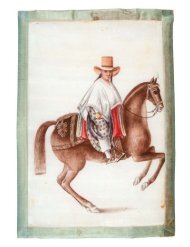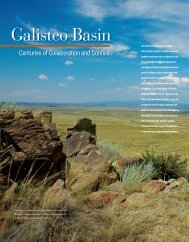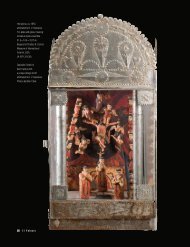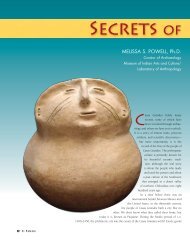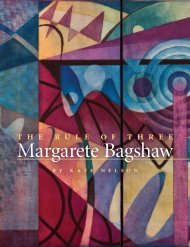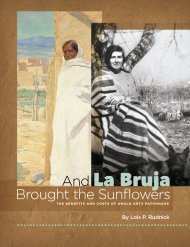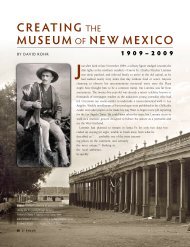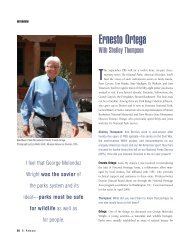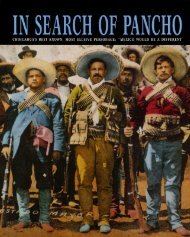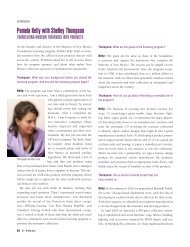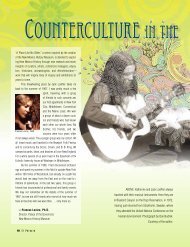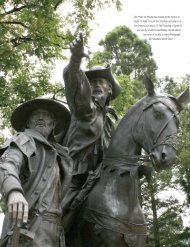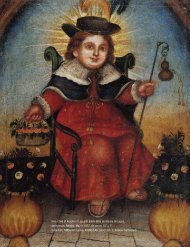Federico Vigils Dichos - El Palacio Magazine
Federico Vigils Dichos - El Palacio Magazine
Federico Vigils Dichos - El Palacio Magazine
You also want an ePaper? Increase the reach of your titles
YUMPU automatically turns print PDFs into web optimized ePapers that Google loves.
<strong>Federico</strong> <strong>Vigils</strong> <strong>Dichos</strong><br />
’<br />
By Laura Addison<br />
Curator of Contemporary Art, Museum of Fine Arts<br />
It is said that “a picture is<br />
worth a thousand words.”<br />
Frederico Vigil took this<br />
Hispanic cultural narratives in<br />
both his monumental murals<br />
and these smaller works on<br />
dicho, or saying, to heart when<br />
paper. The messages in both<br />
he began to create images<br />
mediums, however, are equally<br />
based on popular sayings from<br />
profound and universal. Like<br />
Spain and New Mexico seven<br />
many of us, Vigil remembers<br />
years ago. An exhibition of<br />
life lessons from his childhood<br />
Vigil’s paintings of dichos on<br />
through the sayings that his<br />
view at the Museum of Fine<br />
parents and grandparents<br />
Arts showcases this ongoing<br />
used. “They become embedded<br />
project of putting visual images<br />
in you,” he notes of our uncon-<br />
to spoken words of wisdom.<br />
scious absorption of a saying<br />
Through the dichos, Vigil<br />
and its associated meaning. A<br />
found an effective way of com-<br />
dicho such as En boca cerrada<br />
municating his strong sense of<br />
no entran moscas (“Flies don’t<br />
cultural heritage and this<br />
enter a closed mouth”) advises<br />
region’s historical connections<br />
us not to talk too thoughtlessly<br />
to Spain, as well as the univer-<br />
or to gossip. <strong>El</strong> bien no es conosality<br />
of sayings as a teaching<br />
cido hasta que es perdido (“You<br />
method in all civilizations.<br />
don’t know what you’ve got<br />
<strong>Dichos</strong> communicate the<br />
until it’s gone”) is a truism we<br />
values and customs of a given<br />
have all experienced at one<br />
community—focusing on its En boca cerrada no entran moscas. (“Flies don’t enter a closed mouth,” point or another.<br />
morality, social dynamics, or, “if you keep your mouth shut, you won’t put your foot in it.”)<br />
One of the experiences that<br />
individual responsibility, and Frederico Vigil, 1999, aqua crayon, gouache, and ink on handmade<br />
prompted Vigil to paint<br />
relationship to the rest of the amate paper, 23 x 15 in. Courtesy of the artist.<br />
dichos was a visit to the<br />
world. They are bits of knowl-<br />
Museo del Prado in Madrid,<br />
edge that prolong collective<br />
Spain, where he saw<br />
memory and teach life lessons across generations. “<strong>El</strong>ders use Francisco Goya’s powerful series Los Caprichos (1799). Goya’s<br />
dichos to instruct children,” says Vigil. “<strong>Dichos</strong> come so natu- etchings, translated as The Caprices, were done in response to<br />
rally in an appropriate moment to convey an important the social ills and political abuses and repression that the<br />
message. They are a sort of shorthand used during a dialogue Spanish artist observed around him. They are incisive com-<br />
to teach a lesson. They make us look at our own lives.” mentaries about human nature, with its frailties and follies.<br />
Although better known for his fresco work (such as his 1998 Viewing these works made Vigil think about other ways in<br />
Exodus, Influencias Positivas y Compadrazgo in the Museum of Fine which language and images could be combined to express<br />
Arts patio), Vigil employs the same social realist style and pearls of wisdom about humanity. The Spanish-language<br />
48 <strong>El</strong> <strong>Palacio</strong>
dichos that he grew up with provided precisely that<br />
opportunity.<br />
When a particular dicho becomes the impetus for one of<br />
Vigil’s paintings, executed in crayon, ink, and gouache on<br />
handmade amate, or bark paper, he may create a literal representation<br />
of the dicho, or imagine a scenario that might cause<br />
someone to invoke the saying. There is humor conveyed by<br />
some, sadness by others, a sense of justice or injustice served<br />
by still others. In viewing Vigil’s <strong>Dichos</strong>, one begins to recognize<br />
that the entire spectrum of human emotion and experience is<br />
covered in these pithy sayings, which have become such a<br />
familiar part of everyday life.<br />
Through the works in this exhibition, Vigil explores the<br />
similarities that exist between Spanish and New Mexican<br />
Bañarse en agua de rosas no pudo remediarlo; viendo satisfecha la justicia, se baña en<br />
agua de rosas. (“Bathing in rose water couldn’t solve the problem; seeing justice met, he<br />
bathed in rose water.”) Frederico Vigil, 1999, aqua crayon, gouache, and ink on hand-<br />
made amate paper, 23 x 15 in. Courtesy of the artist.<br />
ON EXHIBIT<br />
<strong>El</strong> bien no es conocido hasta que es perdido. Nadie sabe lo que tiene hasta que lo<br />
pierde. (“You don’t know what you’ve got until it’s gone.”) Frederico Vigil, 1999, aqua<br />
crayon, gouache, and ink on handmade amate paper, 23 x 15 in. Courtesy of the artist.<br />
dichos. He finds great continuity in this linguistic form, despite<br />
theocean that separates the two places. Like other Spanish<br />
colonial artistic practices still thriving today in New Mexico,<br />
such as saint making, Vigil’s <strong>Dichos</strong> trace the transmission and<br />
transformation of culture from Spain to the New World, from<br />
past to present. As the old saying goes, “the fruit doesn’t fall far<br />
from the tree.” ■<br />
EXHIBIT NOTE: Frederico Vigil’s <strong>Dichos</strong>, an exhibit of vivid images and dichos<br />
(Spanish words, poems, and proverbs), is on display at the Museum of Fine Arts from<br />
June 23–September 17, 2006. Based on dichos he learned as a youth growing up in<br />
northern New Mexico, Vigil’s works on paper are a powerful way of conveying the<br />
artist’s strong sense of his Hispanic heritage. The exhibition explores the similarities<br />
that exist between these pity sayings from both Spain and New Mexico that have<br />
become such a familiar part of everyday life. This exhibit has toured in Spain since<br />
2001, including the cities of Grenada and Salamanca.<br />
<strong>El</strong> <strong>Palacio</strong> 49


